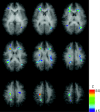Cognitive functions correlate with white matter architecture in a normal pediatric population: a diffusion tensor MRI study
- PMID: 15858815
- PMCID: PMC1859842
- DOI: 10.1002/hbm.20149
Cognitive functions correlate with white matter architecture in a normal pediatric population: a diffusion tensor MRI study
Abstract
A possible relationship between cognitive abilities and white matter structure as assessed by magnetic resonance diffusion tensor imaging (DTI) was investigated in the pediatric population. DTI was performed on 47 normal children ages 5-18. Using a voxelwise analysis technique, the fractional anisotropy (FA) and mean diffusivity (MD) were tested for significant correlations with Wechsler full-scale IQ scores, with subject age and gender used as covariates. Regions displaying significant positive correlations of IQ scores with FA were found bilaterally in white matter association areas, including frontal and occipito-parietal areas. No regions were found exhibiting correlations of IQ with MD except for one frontal area significantly overlapping a region containing a significant correlation with FA. The positive direction of the correlation with FA is the same as that found previously with age, and indicates a positive relationship between fiber organization and/or density with cognitive function. The results are consistent with the hypothesis that regionally specific increased fiber organization is a mechanism responsible for the normal development of white matter tracts.
Copyright 2005 Wiley-Liss, Inc.
Figures




Similar articles
-
Diffusion tensor imaging reveals white matter microstructure correlations with auditory processing ability.Ear Hear. 2011 Mar-Apr;32(2):156-67. doi: 10.1097/AUD.0b013e3181f7a481. Ear Hear. 2011. PMID: 21063207 Free PMC article.
-
Postshunt lateral ventricular volume, white matter integrity, and intellectual outcomes in spina bifida and hydrocephalus.J Neurosurg Pediatr. 2015 Apr;15(4):410-9. doi: 10.3171/2014.10.PEDS13644. Epub 2015 Jan 30. J Neurosurg Pediatr. 2015. PMID: 25634821
-
White matter development in children with benign childhood epilepsy with centro-temporal spikes.Brain. 2014 Apr;137(Pt 4):1095-106. doi: 10.1093/brain/awu039. Epub 2014 Mar 4. Brain. 2014. PMID: 24598359
-
The role of diffusion tensor imaging and fractional anisotropy in the evaluation of patients with idiopathic normal pressure hydrocephalus: a literature review.Neurosurg Focus. 2016 Sep;41(3):E12. doi: 10.3171/2016.6.FOCUS16192. Neurosurg Focus. 2016. PMID: 27581308 Review.
-
White matter development during adolescence as shown by diffusion MRI.Brain Cogn. 2010 Feb;72(1):16-25. doi: 10.1016/j.bandc.2009.06.005. Epub 2009 Jul 22. Brain Cogn. 2010. PMID: 19628324 Review.
Cited by
-
Maternal adiposity negatively influences infant brain white matter development.Obesity (Silver Spring). 2015 May;23(5):1047-54. doi: 10.1002/oby.21055. Obesity (Silver Spring). 2015. PMID: 25919924 Free PMC article.
-
Maternal Diet Quality during Pregnancy Is Associated with Neonatal Brain White Matter Development.Nutrients. 2023 Dec 15;15(24):5114. doi: 10.3390/nu15245114. Nutrients. 2023. PMID: 38140373 Free PMC article.
-
Emotion regulation and trait anxiety are predicted by the microstructure of fibers between amygdala and prefrontal cortex.J Neurosci. 2015 Apr 15;35(15):6020-7. doi: 10.1523/JNEUROSCI.3659-14.2015. J Neurosci. 2015. PMID: 25878275 Free PMC article.
-
Specific effect of the fragile-X mental retardation-1 gene (FMR1) on white matter microstructure.Br J Psychiatry. 2015 Aug;207(2):143-8. doi: 10.1192/bjp.bp.114.151654. Epub 2015 Mar 19. Br J Psychiatry. 2015. PMID: 25792692 Free PMC article.
-
Pubertal development of the understanding of social emotions: Implications for education.Learn Individ Differ. 2011 Dec;21(6):681-689. doi: 10.1016/j.lindif.2010.05.007. Learn Individ Differ. 2011. PMID: 22211052 Free PMC article.
References
-
- Adler CM, Holland SK, Schmithorst V, Wilke M, Weiss KL, Pan H, Strakowski SM (2004): Abnormal frontal white matter tracts in bipolar disorder: a diffusion tensor imaging study. Bipolar Disord 6: 197–203. - PubMed
-
- Baratti C, Barnett AS, Pierpaoli C (1999): Comparative MR imaging study of brain maturation in kittens with T1, T2, and the trace of the diffusion tensor. Radiology 210: 133–142. - PubMed
-
- Baslow MH (2002): Evidence supporting a role for N‐acetyl‐L‐aspartate as a molecular water pump in myelinated neurons in the central nervous system. An analytical review. Neurochem Int 40: 295–300. - PubMed
-
- Cabeza R, Nyberg L (2000): Imaging cognition. II. An empirical review of 275 PET and fMRI studies. J Cogn Neurosci 12: 1–47. - PubMed
Publication types
MeSH terms
Grants and funding
LinkOut - more resources
Full Text Sources

